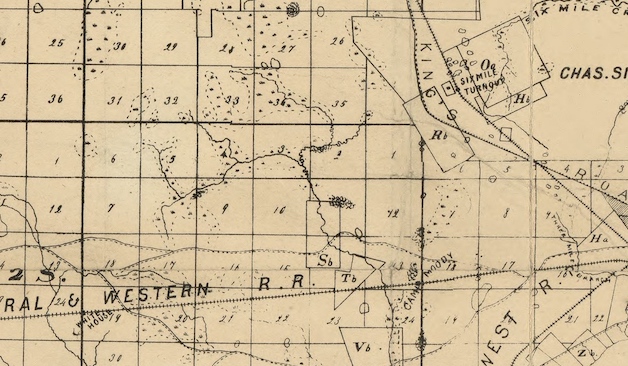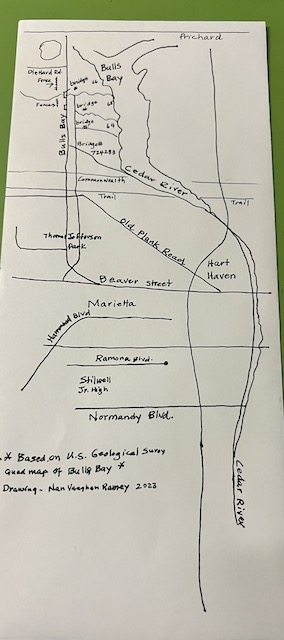Isaiah D. Hart’s Westside Plantation
(About 1840 near now called Marietta)
Isaiah D. Hart, the founder of Jacksonville died September 4, 1861 at the age of 68. He was born in Georgia before moving to King’s Ferry along the St. Marys River . He came to the Cowford, (former Jacksonville), planned and had platted the area into streets and a township in 1822. T. Frederick Davis, author of History of Jacksonville wrote: “At one time or another he owned nearly all the land now known as the old city, and the most of Springfield”. We know he also owned property in West Jacksonville out by Bulls Bay as documented in old records, by former historians and recently online at Wikitree.

It is believed that he had seen the business of Dawson and Buckles near the St. Johns River where two men who opened a general merchandise store and were finding success being near the place where people crossed, fording cows and the like. Hart purchased 18 acres of land in the area and established a town, now called Jacksonville, Florida.

As a young man, Hart was in favor of Spain returning Florida and joined in the Patriot raids which “raided Florida plantations for slaves and called and drove them northward into Georgia selling them”. About that time he married Nancy Nelson and as the United States took control of Florida Hart was busy securing land in the Cowford and other Florida areas beginning to make his fortune.
By 1840, Hart and his family were living on his Paradise plantation in West Jacksonville. According to a census taker in 1850 he was named as a “planter” with his estate being valued at $35,000 having 48 slaves(21 female and 27 male). By 1860 his owning had diminished having 12 female and 14 male slaves.
Hart had 8 children and at his death his son Ossian was assigned to settle his estate. Ossian chose to live at the plantation Hart owned on the outskirts of Jacksonville near Marietta in now West Jacksonville even though Isaiah had other property. These were Civil War years and change was on the rise.
The Civil War began in April of 1861 and with Hart’s passing in September of that year, times were beginning to change even in Florida. By the 1860’s, Hart was quite established.
The Civil War and the battle about emancipation was on the minds of many. Although two of the most significant battles did not occur in Florida until 1864 near Olustee and Lake City, Hart’s ,Paradise Plantation in West Jacksonville was only 40-50 miles from those battle areas. Change was on the rise.
Only 4 years before his death, in 1857 Hart added all of his property holdings to the Jacksonville map and established a public square. After his death the family deeded the village green which was known as City Park to the city. In 1800 Civil War veteran Charles C. Hemming installed a 62 foot tall confederate monument and the park was renamed Hemming Park about 1898 and remained so until the unrest of the police killing of George Floyd. This sparked outcry nationwide. In 2020, the City Council voted to change the name of Hemming Park to James Weldon Johnson Park in honor of a former Black Jacksonville musician and “accomplished resident.”
Ossian, Hart’s son had been born in Jacksonville in 1821. He was educated in Jacksonville and Washington, Dc according to the Governor’s Association. He studied law and was admitted into the Florida bar. Serving in the Florida Legislature as a one-term member in 1844 he became Florida supervisor of elections and helped in the restoration of the state. Hart was a Unionist and avoided the Confederate army due to medical concerns. When his father died, he managed his father’s property dividing the estate. His father was one of the richest men in Florida owning stocks in” the Florida, Atlantic and Gulf Railroad, the Jacksonville Natural Gas Company, the Banks of St. Johns County a steamship line, a great amount of property and 53 slaves” From that time of 1861 until after the Civil War, he worked in government serving in 1873 on the Supreme Court. He was elected the 10th Florida governor. Ossian’s position on slavery was in helping them and offering freedom as he managed his Father’s 30 year old plantation estate.
It is said that Hart’s slaves were freed after his death and when his son served as governor worked in an effort to help with the freedmen and new accomplishments and freedoms for Blacks. For example, Ossian Hart appointed the first Black superintendent of public instruction, Jonathan Gibbs during the Reconstruction era.
Ossian Hart came down with pneumonia while serving as Governor and died in office on March 18, 1874. He is buried next to his father in Evergreen Cemetery in Jacksonville, Florida.
There’s so much more, so….
See you tomorrow,

SourcesL The Governors Association, Wikipedia, Ancestry, Canter Brown, T. Frederick Davis, Wikitree, Geological map, Florida Memory.